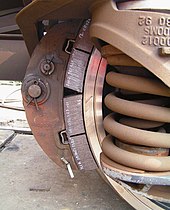Composite brake block
As composite brake blocks (also briefly K block ) are on rail vehicles used brake pads made of composite materials designated. In vehicles in which the brake blocks act on the cycling surface, they contribute to a reduced wheel-rail noise of 8 to 10 dB (A) by - unlike the gray cast iron brake blocks that are still used as standard equipment today - the driving surfaces Do not roughen the wheelsets when braking . This is achieved by using more elastic materials, usually a combination of metal fibers and rubber - resin compounds as well as additional additives . The equipment with K-blocks and the adaptation of the brake system to the higher coefficient of friction compared to the gray cast iron brake blocks is also called whisper brake . K-soles have been internationally approved since 2003, and the even newer LL-soles since 2013, whereby LL stands for "low noise, low friction" ("less noise, less wear and tear").
On freight wagons , the brake pads usually act on the wheel treads, so that the sum of the roughness of the wheel and rail in the area of the contact surface is higher than on vehicles with other braking systems. This cumulative roughness of the contact surface significantly determines the level of the wheel-rail noise dominating the driving noise. The noise emissions from non-powered vehicles are therefore reduced through the use of K-blocks over the entire speed range.
New freight wagons of Deutsche Bahn have been fitted with composite brake blocks as standard since 2001. At the end of 2003, the International Union of Railways granted unlimited approval of the K block in European rail freight transport . The European state railways , which are members of the Community of European Railways (CER), have committed to procure new wagons exclusively with K-blocks.
By 2020, all DB Cargo wagons should be equipped with K or LL brake blocks. In December 2016, a law prepared by Federal Transport Minister Alexander Dobrindt was passed that prohibits the use of other wagons in the territory of the Federal Republic of Germany after the timetable change in December 2020.
The Swedish transport authority Trafikverket , however, reported a greatly reduced braking performance with organic K-soles of the type C810 in winter weather conditions.
Web links
See also
Individual evidence
- ↑ Damping of wheel and structural vibrations ( Memento of December 8, 2015 in the Internet Archive ) (PDF).
- ↑ a b Katja Bammel: Leise roll the wheel. In: Physik Journal 6 (2007) No. 11.
- ↑ Message K brake approved. In: Eisenbahn-Revue International . Issue 12/2003, ISSN 1421-2811 , p. 554.
- ↑ Halving of rail traffic noise by 2020. On quiet feet. DB Schenker Rail AG, January 28, 2015, accessed on August 23, 2015 .
- ↑ https://www.24matins.de/topnews/eco/fahrverbot-fuer-laute-gueterwagen-auf-der-schiene-ab-ende-2020-18029
- ↑ Reinhard Wolff: Whisper brakes do not brake properly. In: taz. Retrieved October 2, 2017 .
